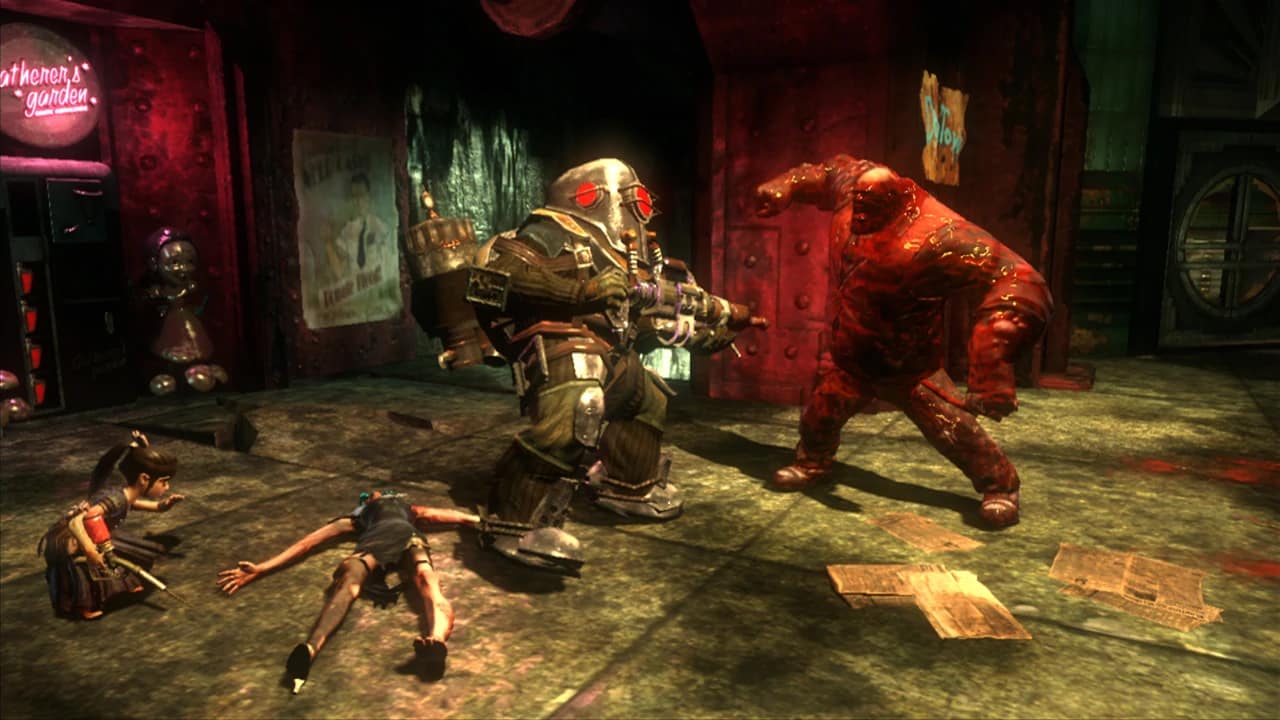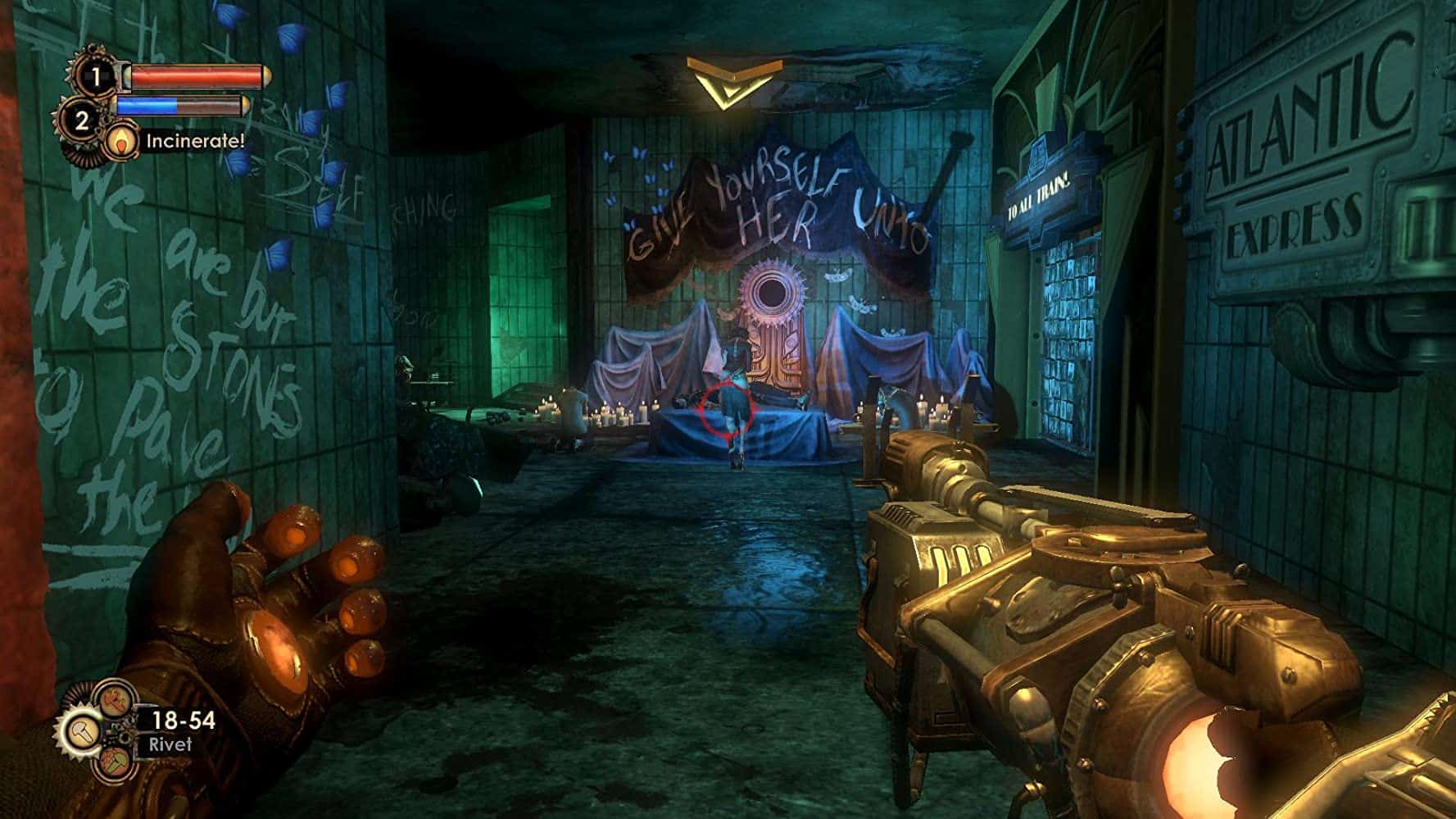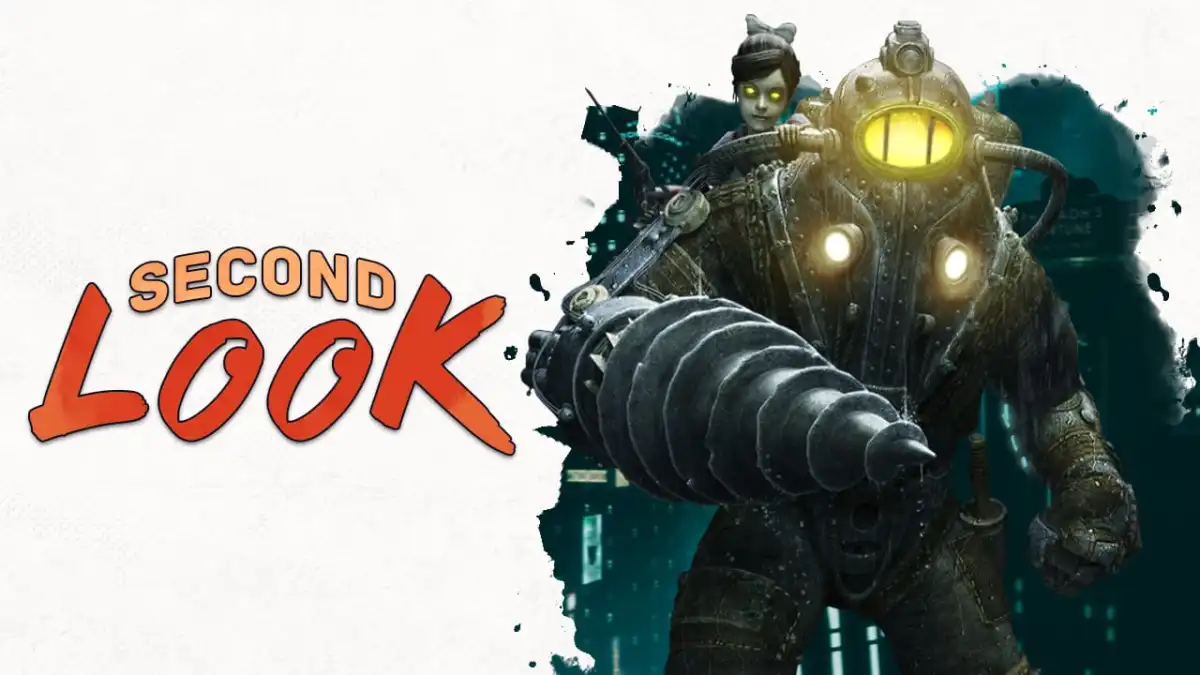This column began with 2K Marin’s brilliant yet underappreciated The Bureau: XCOM Declassified. It was only a matter of time before we’d circle back to the studio’s first project, BioShock 2. And let’s be real — BioShock 2 did not release to a graceful fan reception. It was dismissed as a derivative sequel with a bigger emphasis on shooting over thoughtful ideas. Many regarded its story as redundant. This is rather ironic given it fixes virtually every problem of the first game, plays better, and offers a vastly more nuanced exploration of the themes of its predecessor in addition to its own. Plus, it’s gorgeous, boasts amazing sound design, and even has a stellar multiplayer component.
Out of all the underwater denizens of Andrew Ryan’s city of Rapture in BioShock, the hulking Big Daddies have always been the cornerstone. They’re the towering titans on the box art and in every trailer. Their massive drills and monstrous diving suits are as enigmatic as they are terrifying in a duel. While the first game teased at what it was like to become one of these biomechanical beings and guide their unnerving Little Sister gatherers, BioShock 2 thrusts you into the boots of one of the very first — Subject Delta.
Delta is an Alpha Series Big Daddy. As such, he can think for himself, and his connection with Little Sister Eleanor is genuine. Despite their terrible circumstances, they’re family. Unfortunately for them, Eleanor’s mother, Dr. Sofia Lamb, wants her daughter back. So when Sofia’s collectivist faction in Rapture turns the tables on Delta right on the eve of Rapture’s civil war, it ends with Delta being forced to put a bullet in his head via mind control. Years later, a teenage Eleanor is able to command her fellow Little Sisters to revive Delta so that the original Big Daddy can fix things. He sets out on his quest to stop Sofia, save Eleanor, and maybe, just maybe, rediscover his humanity.

It’s a story with a surprising amount of heart and nuance. Rather than another gruff-but-lovable father figure, Delta lost his voice in becoming a Big Daddy. Instead, he’s a man of action, with hard choices. You don’t have to kill everyone in Rapture, but that doesn’t mean there isn’t justification. Several people who helped lead to Delta and Eleanor’s transformation cross your path, and it’s up to you whether to smite them or be merciful. Rather than simply flipping a coin on which ending this gets you, your actions instead shape Eleanor as she watches you from afar. While obviously being wholly kind or murderous will inspire the same in Eleanor, BioShock 2 improves upon its predecessor by respecting those who walk the neutral path. In fact, there are multiple neutral endings.
Beyond Eleanor, every new location, character, and audio diary exists to not only strengthen the original game’s narrative, but expand it artfully. BioShock 2 provides elaboration on many questions risen by the first game, like where the poor people of Rapture went, how Ryan kept the peace for so many years, and how a red light district works in a purely capitalist society. Pauper’s Drop is a makeshift shanty town that was decayed and miserable long before Rapture fell to civil war, eager to join Sofia’s cause. A collectivist like Sofia infiltrated Rapture’s society because Ryan thought a psychologist might be able to calm the crowds, unwittingly inviting another opponent into the ring between himself and Frank Fontaine. And let’s just say that Siren Alley may be one of the most alarming brotherly rivalries ever depicted in gaming.
Everything about BioShock 2, from its storytelling to its gameplay, is crafted with this benefit of hindsight by Irrational Games veterans, led by creative director Jordan Thomas. You might not know Thomas, but every fan knows his marvelous work on the level Fort Frolic. It was the ideal team, and they aimed high. Not only would morality be more than choosing to consume or save the Little Sisters, but the girls would have a bigger part to play, with you guarding them as they gather ADAM for you. Plus, no more clunky swapping between Plasmids and standard weapons or having to freeze time for an elaborate hacking minigame. Most importantly, the story wouldn’t center itself around a single major twist, but instead the cohesive throughline of Delta and Sofia fighting over Eleanor.
Then it went through a ton of changes, enough worthy of their own article. You can actually see a few of them in action in the game’s E3 demo:
Remarkably, it all panned out for the better. Big Sister, a planned antagonist more in the vein of Alien: Isolation’s Xenomorph, became Big Sisters. This led to fantastic encounters where you had the gratification of victory, as opposed to the nuisance of being hounded by an opponent who wouldn’t die. Your radio companion, Augustus Sinclair, serves as the perfect opposite to both previous earworms, Atlas and Brigid Tenenbaum. Sinclair’s Southern drawl and charismatic pragmatism play wonderfully as he serves as both angel and devil on your shoulder, making his more redeeming moments all the more impactful.
You’re granted numerous more ways to interact with the world, with a simpler and more satisfying hacking system and a wide array of defensive options like trap rivets and placeable Plasmids that are also handy for ambushing. Enemy variety has improved dramatically to match, with both agile and brute splicers harnessing the greater verticality to levels. Despite technically being more linear, the world of BioShock 2 feels greater, with larger sandboxes full of choices rather than a larger smattering of smaller arenas to work with.
Yes, it’s more shoot-y, but it also has the better controls and responsiveness to warrant it. Otherwise, its environments are more enjoyable to navigate, rewarding careful observation and clever thinking over a fast trigger finger. Know what you’re doing, and you can navigate whole rooms with nary a scratch. Charge in for a fight, and BioShock 2 gives you one. It’s a remarkable ebb and flow that keeps the tempo rising up till the very end.
Rather than a cliche boss fight, BioShock 2’s subversion in the finale is handing you the most powerful person in Rapture as an ally. You’re the boss fight, holding the line against Sofia’s army as you and an empowered Eleanor save (or devour) the Little Sisters. Just like with The Bureau, 2K Marin nails the ending beautifully, as all your choices and play style come to the fore. By the time the war is over and you can finally rest, you’re left speechless.

Often on this column, there’s one or two saving graces to the flawed gems and oddities I explore. Yet there are enough things done right in BioShock 2 that I could talk about it for a solid month and probably still have some topics leftover. What I can at least say with absolute certainty is that BioShock 2 is easily the series’s peak, and that’s without even bringing up the magnificent Minerva’s Den.
Whereas the first relies on heavy-handed moral arguments and Infinite… was a thing that happened, BioShock 2 just wants to do its job to the best of its ability and give Rapture a proper send-off. And it is a marvelous last dance through the dilapidated halls of Andrew Ryan’s dystopia. It’s immensely replayable; it explores the original game’s themes of family, corruption, and dogma through multiple new lenses; and it’s just really fun to play.
That said, don’t play the remaster — I’m amazed at the issues I had playing it to refresh my memory on the game. The original release got a Steamworks port with almost all the DLC bundled for free on PC, and it’ll run on virtually any hardware these days. Grab that version, and have a blast. It’s a Circus of Values!






Published: Apr 23, 2020 11:00 am